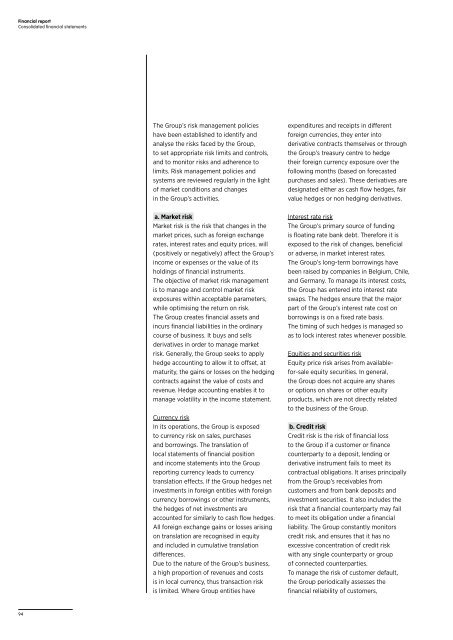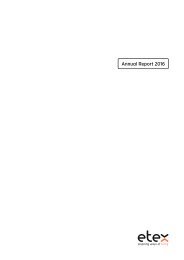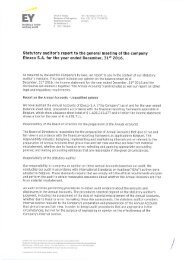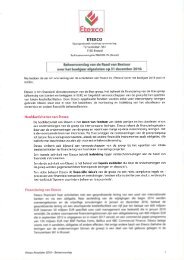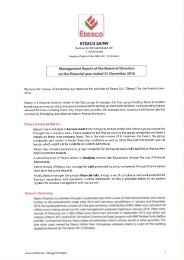Annual Report 2014
This is the 2014 annual report of Etex Group
This is the 2014 annual report of Etex Group
Create successful ePaper yourself
Turn your PDF publications into a flip-book with our unique Google optimized e-Paper software.
Financial report<br />
Consolidated financial statements<br />
The Group’s risk management policies<br />
have been established to identify and<br />
analyse the risks faced by the Group,<br />
to set appropriate risk limits and controls,<br />
and to monitor risks and adherence to<br />
limits. Risk management policies and<br />
systems are reviewed regularly in the light<br />
of market conditions and changes<br />
in the Group’s activities.<br />
a. Market risk<br />
Market risk is the risk that changes in the<br />
market prices, such as foreign exchange<br />
rates, interest rates and equity prices, will<br />
(positively or negatively) affect the Group’s<br />
income or expenses or the value of its<br />
holdings of financial instruments.<br />
The objective of market risk management<br />
is to manage and control market risk<br />
exposures within acceptable parameters,<br />
while optimising the return on risk.<br />
The Group creates financial assets and<br />
incurs financial liabilities in the ordinary<br />
course of business. It buys and sells<br />
derivatives in order to manage market<br />
risk. Generally, the Group seeks to apply<br />
hedge accounting to allow it to offset, at<br />
maturity, the gains or losses on the hedging<br />
contracts against the value of costs and<br />
revenue. Hedge accounting enables it to<br />
manage volatility in the income statement.<br />
Currency risk<br />
In its operations, the Group is exposed<br />
to currency risk on sales, purchases<br />
and borrowings. The translation of<br />
local statements of financial position<br />
and income statements into the Group<br />
reporting currency leads to currency<br />
translation effects. If the Group hedges net<br />
investments in foreign entities with foreign<br />
currency borrowings or other instruments,<br />
the hedges of net investments are<br />
accounted for similarly to cash flow hedges.<br />
All foreign exchange gains or losses arising<br />
on translation are recognised in equity<br />
and included in cumulative translation<br />
differences.<br />
Due to the nature of the Group’s business,<br />
a high proportion of revenues and costs<br />
is in local currency, thus transaction risk<br />
is limited. Where Group entities have<br />
expenditures and receipts in different<br />
foreign currencies, they enter into<br />
derivative contracts themselves or through<br />
the Group’s treasury centre to hedge<br />
their foreign currency exposure over the<br />
following months (based on forecasted<br />
purchases and sales). These derivatives are<br />
designated either as cash flow hedges, fair<br />
value hedges or non hedging derivatives.<br />
Interest rate risk<br />
The Group’s primary source of funding<br />
is floating rate bank debt. Therefore it is<br />
exposed to the risk of changes, beneficial<br />
or adverse, in market interest rates.<br />
The Group’s long-term borrowings have<br />
been raised by companies in Belgium, Chile,<br />
and Germany. To manage its interest costs,<br />
the Group has entered into interest rate<br />
swaps. The hedges ensure that the major<br />
part of the Group’s interest rate cost on<br />
borrowings is on a fixed rate basis.<br />
The timing of such hedges is managed so<br />
as to lock interest rates whenever possible.<br />
Equities and securities risk<br />
Equity price risk arises from availablefor-sale<br />
equity securities. In general,<br />
the Group does not acquire any shares<br />
or options on shares or other equity<br />
products, which are not directly related<br />
to the business of the Group.<br />
b. Credit risk<br />
Credit risk is the risk of financial loss<br />
to the Group if a customer or finance<br />
counterparty to a deposit, lending or<br />
derivative instrument fails to meet its<br />
contractual obligations. It arises principally<br />
from the Group’s receivables from<br />
customers and from bank deposits and<br />
investment securities. It also includes the<br />
risk that a financial counterparty may fail<br />
to meet its obligation under a financial<br />
liability. The Group constantly monitors<br />
credit risk, and ensures that it has no<br />
excessive concentration of credit risk<br />
with any single counterparty or group<br />
of connected counterparties.<br />
To manage the risk of customer default,<br />
the Group periodically assesses the<br />
financial reliability of customers,<br />
94


